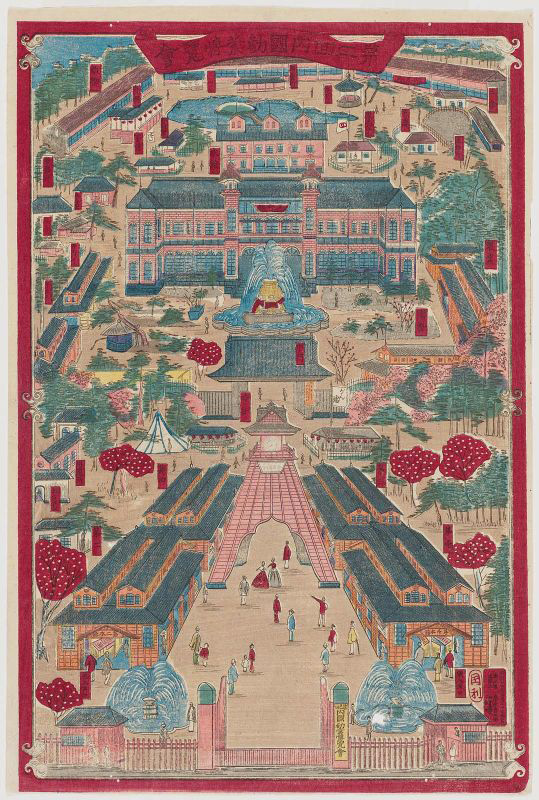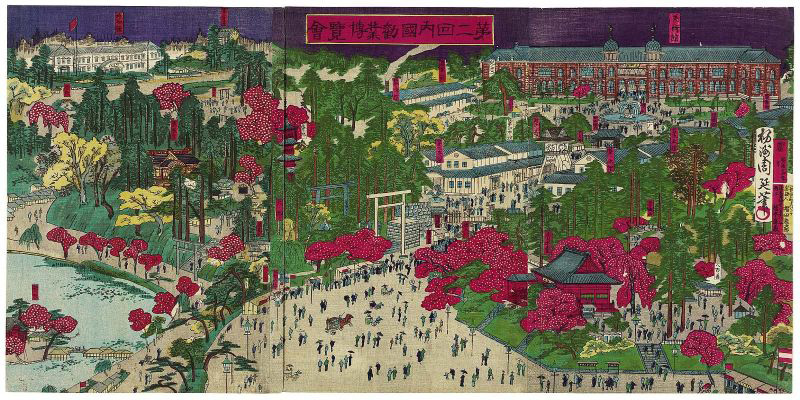About This Print
A "quick and dirty" triptych giving us a bird's eye view of the notable sites at the Second National Industrial Exposition held in 1881 a Ueno Park in Tokyo from March 1 through June 30.The view provided here by Kunitoshi omits the most famous building at the Exposition, the young British architect Josiah Conder's new art museum with its distinctive twin domed towers. (See IHL Cat. #105 and IHL Cat. #1222 for depictions of Conder's museum.) The Western-style brick building in the upper portion of right panel is the art museum from the the First National Industrial Exhibition held in 1877, which was retained "to serve as a permanent extension to the future museum complex," the cornerstone of which was to be Conder's museum.1 Another print by Kunitoshi dated March 11, 1881 (shown below) shows both the new Conder building and the old brick building and a bird's eye panorama done by Yōshū Chikanobu (1838-1912) (also below) prominently features Conder's museum. It may be that the new art museum was not yet completed when this print was published at the end of January 1881.2
1 "Styling Japan: The Case of Josiah Conder and the Museum at Ueno", Alice Y. Tseng appearing in the Journal of the Society of Architectural Historians, Vol. 63, No. 4 (Dec., 2004), University of California Press on behalf of the Society of Architectural Historians, p. 472-497
2 I have not been able to find a specific date of completion for Conder's museum, although it likely coincided with the Exposition's March 1, 1881 opening. Its official opening to the public as a museum, post-Exposition, was in March 1882, with the Emperor in attendance.
List of Places as Named in the Red Cartouches
Note: The below is my attempt at translation of the 16 buildings listed on the print and likely contains errors.
Right Sheet:
| 八百善 | Yaozen | a famous restaurant founded in 1717 in the Sanya district of Asakusa |
| 清水堂 | Kiyomizudō | modeled after Kiyomizudera in Kyoto |
| 第三 | The third [exhibition hall] | |
| 本館 | Main Hall | the Art Museum designed by Hayashi Tadahiro built for the 1877 First National Industrial Exhibition |
| 園芸館 | Horticulture Hall | |
| スリバチ山 | Suribachiyama | the highest point in Ueno Park |
Center Sheet:
| 第壱 | The first [exhibition hall] | located near the entrance |
| 第四 | The fourth [exhibition hall] | |
| 第弐 | The second [exhibition hall] | |
| 機カイ館 [機械館] | Machinery Hall | |
| 児ノ松 | Kono matsu? | |
| 勧業館 | Industry Hall | |
| 時計 | Clock Tower |
Left Sheet:
| 教育博物館 | Museum of Education | |
| 東照宮 | Toshogu Shrine | built in 1627 and dedicated to Tokugawa Ieyasu |
| 不忍ノ池弁天ノ社 | Shinobazu Pond Benten Shrine | originally built in 1625 this Buddhist temple sits on an island in Shinobazu Pond |
Other Birds-Eye Views of the Exposition
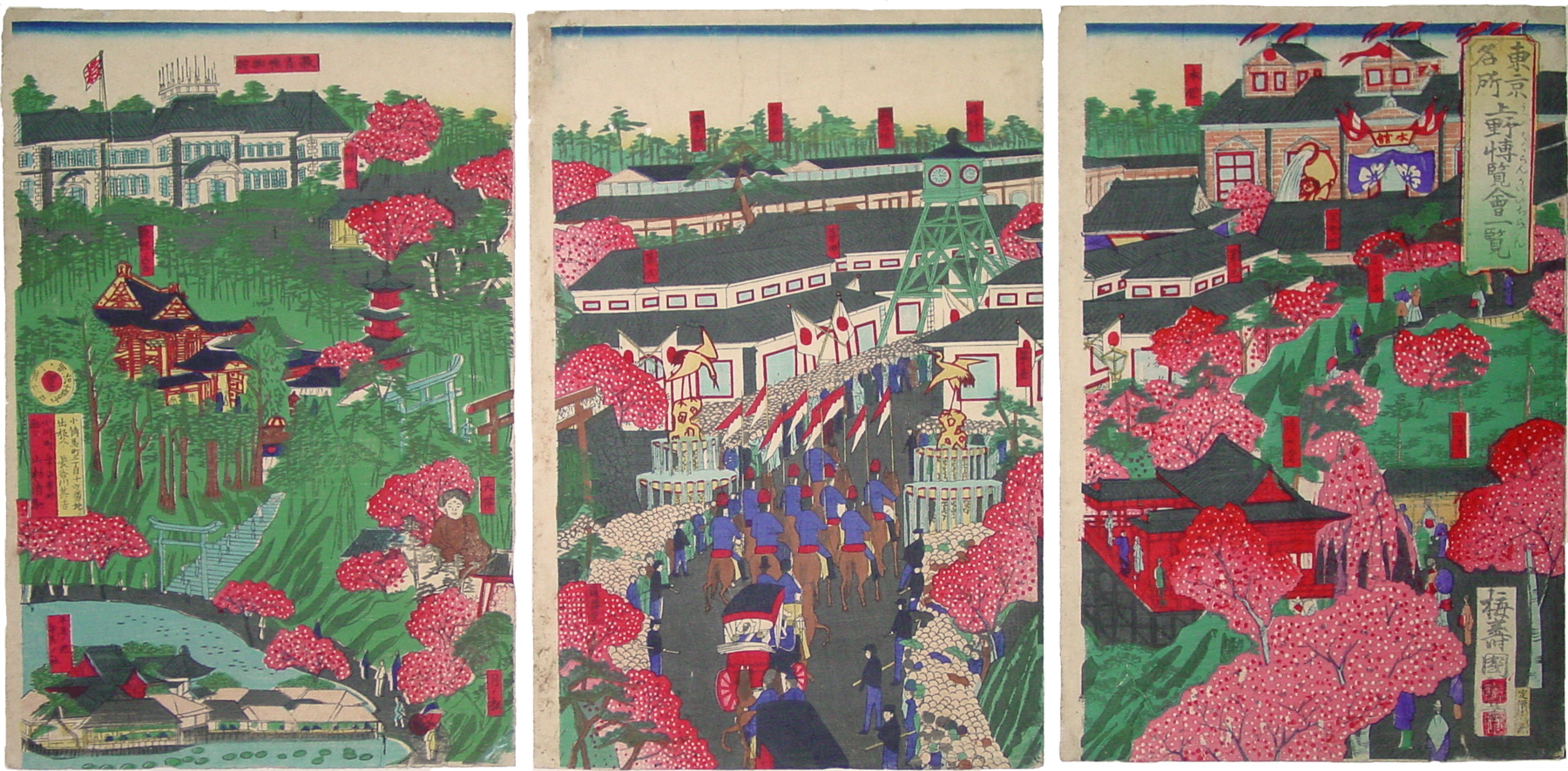 IHL Cat. #477 IHL Cat. #477Chikanobu, The Second National Industrial Exposition (Dainikai naikoku kangyô hakurankai), 1881 (Meiji 14) Museum of Fine Arts, Boston Jean S. and Frederic A. Sharf Collection 2000.390a-c |
Second National Industrial Exhibition
Source: "Promoting Scientific and Technological Change in Tokyo," Morris Low appearing in Urban Modernity: Cultural Innovation in the Second Industrial Revolution, Miriam R. Levin, et. al., The MIT Press, 2010, p. 231"Attendance at the Second National Industrial Exhibition, in 1881, topped that at the first, with over 820,000 visitors over 122 days. The Ministry of Finance joined forces with the Home Ministry to hold the event. The centerpiece of the exhibition was the museum building designed by Josiah Conder. The Western-style building underlined the authority of the new regime, serving to show that Japan was a modern nation, the equal of Western powers. Another attraction – gas lighting – provided further evidence of Japan’s modernity.
There is evidence that the expositions were indeed useful in promoting Japanese industry. For example, the Second Nation Industrial exhibition provide craftsmen with an opportunity to showcase their products. The Tokyo-based Oki Kibatarou exhibited his Microsound device, an Edison-type telephone that used carbon powder instead of carbon rods. It won a second-place award for innovation.
Handmade timepieces were also on display, including two wall clocks, a stand clock, and three pocket watches. However, the Japanese soon realized that such manually produce products could not compete with imported goods. In 1888, Hayashi Shihei established a factory to produce a thousand grandfather clocks a year using machine tools. Thus, the exposition provided the Japanese with an opportunity not only showcase what they could do, but to confront the business realities of what competitors could offer."
Print Details
| IHL Catalog | #477 |
| Title (Description) | A list of noted places at the Second National Industrial Exposition at Ueno Park 東京名所 上野博覧会一覧 Tōkyō Meisho Ueno hakurankai ichiran |
| Artist | Utagawa Kunitoshi (1847-1899) |
| Signature |  |
| Seal | Baiju and Kunitoshi seals (as shown above) |
| Pub. Date | 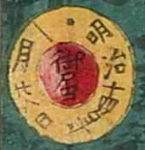 |
| Publisher | 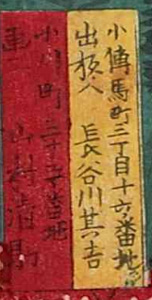 seal reading: yellow cartouche: 小伝馬町三丁目十六番地 [publisher's address] 出板人 長谷川園吉 [publisher Hasegawa Sonokichi] red cartouche: 小川町三十三番地 [artist's address] 画工 山村清助 [artist's given name Yamamura Kiyosuke*] * can also be read Yamamura Seisuke |
| Engraver | |
| Impression | excellent |
| Colors | excellent |
| Condition | good- minor soiling and wrinkling; not backed or joined |
| Genre | ukiyo-e; kaika-e; kaidei-ga |
| Miscellaneous | |
| Format | vertical oban |
| H x W Paper | 14 3/8 x 9 3/4 in. (36.5 x 24.8 cm) each sheet |
| Literature | |
| Collections This Print | Tokyo Metropolitan Library 803-C16 |
4/6/2020


